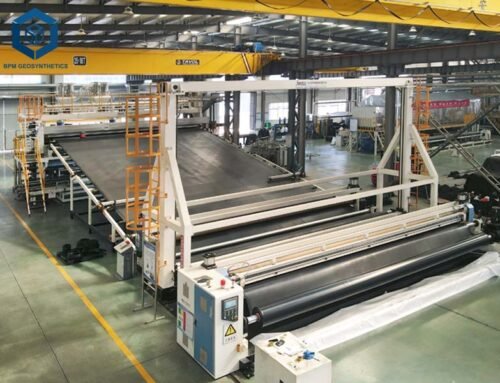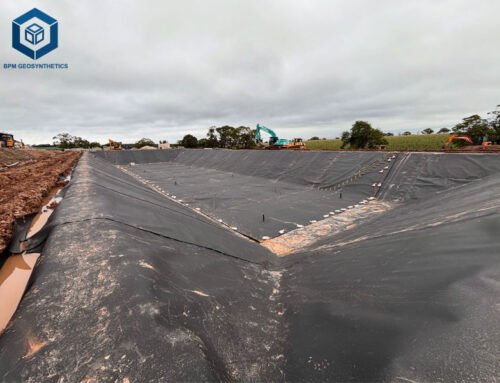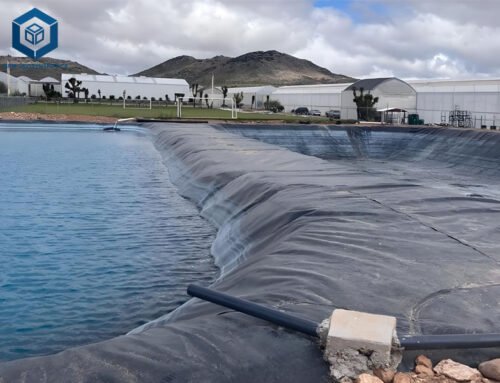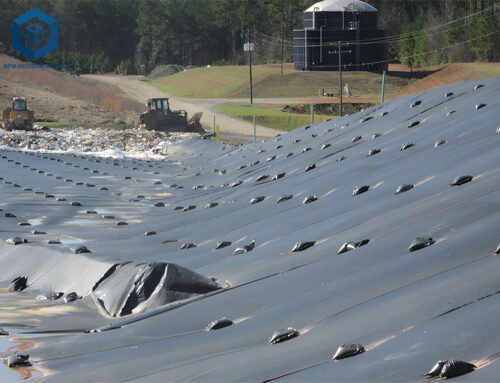Drainage geotextile fabric has become an essential material in civil engineering, construction, and environmental projects due to its superior filtration, separation, and drainage capabilities. As a high-performance geosynthetic solution, it enhances soil stability, prevents clogging, and improves water flow efficiency in various applications. BPM Geosynthetics, a leading manufacturer and supplier, offers premium-quality drainage geotextile fabrics designed to meet international standards, ensuring durability and long-term performance. This article explores the key advantages of using drainage geotextile fabric.
1. What Is Drainage Geotextile Fabric?
Drainage geotextile fabric is a permeable geosynthetic material designed to facilitate efficient water flow while providing filtration and soil stabilization. Typically made from polypropylene or polyester, it combines durability with high hydraulic conductivity, making it ideal for drainage systems in civil engineering, construction, and industrial applications.
Unlike traditional drainage methods, geotextile fabrics prevent soil particles from clogging drainage pipes or aggregate layers, ensuring long-term performance. They are widely used in landfills, road construction, retaining walls, mining operations, and industrial yards where effective water management is critical.
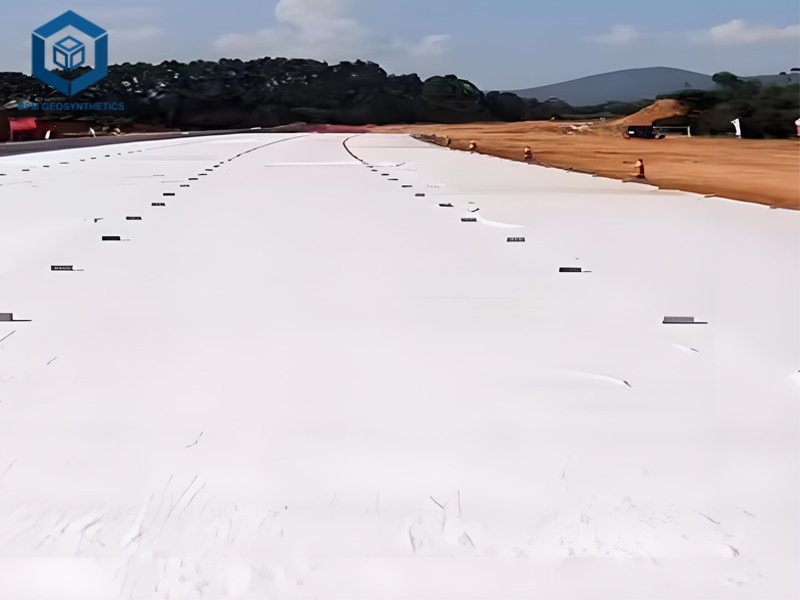

2. Advantages of Drainage Geotextile Fabric
Drainage Geotextile Fabric have multiple functions, including filtration, isolation, reinforcement and protection, water permeability but not soil permeability, puncture resistance and high tensile strength. Specifically:
2.1 Drainage Geotextile Fabric – Filtration:
Drainage geotextile fabric allows air and water to pass through easily. Additionally, it filters out soil particles while maintaining flow. As a result, it improves drainage efficiency in construction projects. Moreover, it prevents soil erosion and stabilizes the ground. Furthermore, it supports long-term structural integrity. Therefore, it is widely used in roads, landfills, and retaining walls. Finally, it ensures sustainable and reliable performance in water management systems.
2.2 Drainage Geotextile Fabric – Isolation:
Geotextile fabric separates different construction materials effectively. Additionally, it prevents unwanted mixing between layers. As a result, each material retains its strength and function. Moreover, it stabilizes soft soils when used with aggregates. Furthermore, it enhances load distribution in road bases. Therefore, it improves long-term project durability. Finally, it reduces maintenance costs by preventing material contamination.
2.3 Drainage Geotextile Fabric – Reinforcement and protection:
Geotextile fabric improves soil stability effectively. Additionally, it helps prevent landslides and ground settlements. Moreover, it performs multiple functions like filtration and drainage. Furthermore, it isolates and reinforces soil layers efficiently. As a result, it reduces road crack formation significantly. Therefore, it extends pavement lifespan remarkably. Finally, it provides cost-effective protection for infrastructure projects.
2.4 Drainage Geotextile Fabric – Water-permeable but not soil-permeable:
Geotextile fabric allows water to pass through freely. However, it effectively blocks soil particles from passing. Additionally, it works well for covering loose dust piles. Moreover, it helps control construction site debris. Furthermore, this material effectively suppresses airborne dust. As a result, it creates better conditions for site greening. Therefore, it serves both environmental and construction purposes efficiently.
2.5 Drainage Geotextile Fabric – Anti-puncture:
Geotextile fabric works effectively with geomembranes. Together, they create a protective barrier against punctures. Additionally, this combination safeguards underlying soil layers. Moreover, it prevents damage from sharp objects. Furthermore, it maintains the geomembrane’s integrity. As a result, the system offers enhanced protection. Therefore, projects gain longer-lasting environmental protection.
2.6 Drainage Geotextile Fabric – High tensile strength:
Drainage Geotextile Fabrichave high tensile strength and can resist stretching and deformation.
These functions make Drainage Geotextile Fabric play an important role in many engineering fields, including landscaping, roadbed reinforcement, road maintenance, dam protection and underground garage drainage.
3. What Are The Industrial Applications Of Drainage Geotextile Fabric?
Drainage geotextile fabric plays a critical role in industrial infrastructure by ensuring efficient water management, soil stabilization, and long-term structural integrity. BPM Geosynthetics, a leading manufacturer of high-performance geosynthetic materials, supplies engineered drainage geotextiles that meet rigorous industrial demands.
Key Industrial Applications
3.1 Mining & Tailings Management
In mining operations, drainage geotextiles prevent soil contamination while managing seepage in tailings storage facilities. BPM’s fabrics enhance filtration in heap leach pads, reducing environmental risks.
3.2 Landfill & Waste Containment Systems
Modern landfills use geotextile-geomembrane composites to optimize leachate collection. BPM’s solutions improve puncture resistance and drainage efficiency in projects like hazardous waste containment sites.
3.3 Industrial Yard & Port Pavements
Heavy-load zones, such as container terminals, rely on geotextiles for subgrade stabilization. BPM’s fabrics distribute loads, preventing rutting and extending pavement life under constant traffic.
3.4 Oil & Gas Infrastructure
In refinery containment basins, drainage geotextiles facilitate hydrocarbon separation while protecting impermeable liners—a critical application where BPM’s chemical-resistant materials excel.
3.5 Power Plant & Renewable Energy Projects
Solar farms and coal ash ponds utilize geotextiles for erosion control. BPM’s UV-stabilized fabrics ensure durability in exposed energy infrastructure.
4. How to Choose the Right Drainage Geotextile Fabric?
Selecting the appropriate drainage geotextile fabric is crucial for ensuring long-term performance in construction, environmental, and industrial projects. Here’s a step-by-step guide to help you make the best choice.
4.1 Determine the Required Function
Drainage geotextiles serve multiple purposes:
- Filtration – Allows water to pass while retaining soil particles.
- Separation – Prevents mixing of different soil layers.
- Reinforcement – Enhances soil stability under heavy loads.
- Drainage – Facilitates efficient water flow.
BPM Geosynthetics offers specialized fabrics for each function, ensuring optimal performance in applications like landfills, mining, and road construction.
4.2 Check Material Composition & Durability
- Polypropylene (PP) – Resistant to chemicals, ideal for harsh environments.
- Polyester (PET) – High strength, suitable for heavy-load applications.
BPM uses premium-grade polymers with UV and chemical resistance, ensuring durability in extreme conditions.
4.3 Evaluate Permeability & Flow Rate
- AOS (Apparent Opening Size) – Determines soil retention capability.
- Permittivity – Measures water flow efficiency.
BPM provides customized permeability options to match project-specific hydraulic requirements.
4.4 Consider Strength & Puncture Resistance
- Tensile Strength – Critical for high-stress applications.
- Puncture Resistance – Essential when used with geomembranes.
BPM’s geotextiles exceed ASTM and ISO standards, offering superior mechanical performance.
4.5 Verify Certifications & Standards
Ensure compliance with:
- ASTM, ISO, GRI – For quality assurance.
- Project-Specific Requirements – Such as landfill liner protection.
BPM’s products are rigorously tested and certified, guaranteeing reliability in regulated industries.
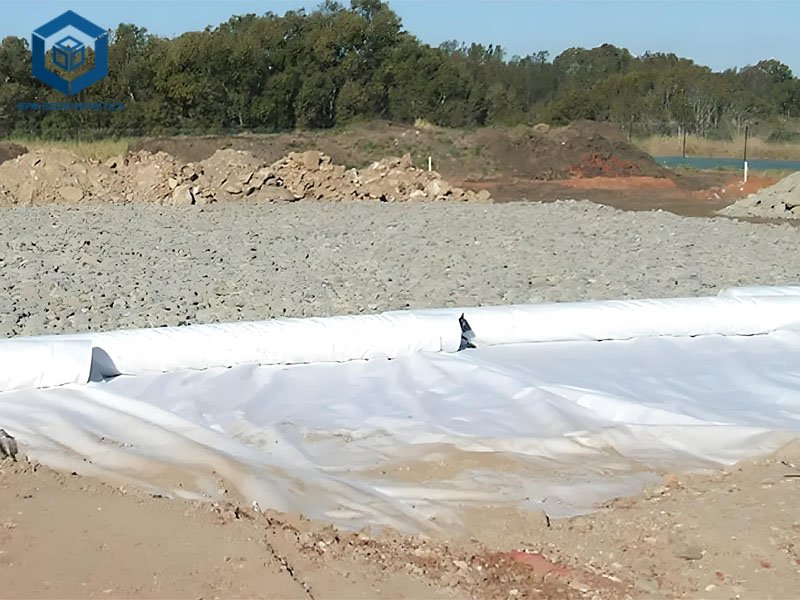
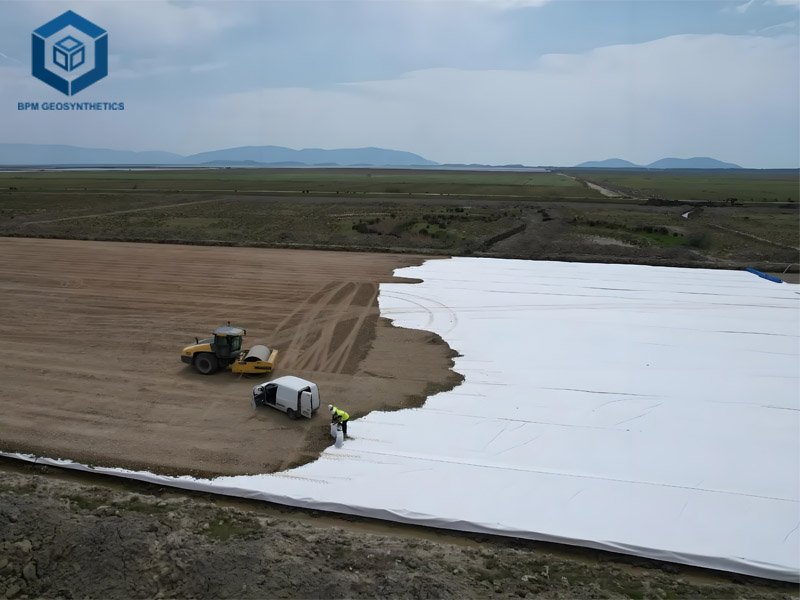
5. What is the laying method of Drainage Geotextile Fabric?
5.1 Laying preparation
- Foundation treatment: Before laying Drainage Geotextile Fabric, ensure that the foundation soil is flat, solid, and has no significant bumps.
- Material inspection: Check whether the Drainage Geotextile Fabric is damaged or has holes to ensure that the material is intact.
5.2 Laying steps
- Positioning and laying: Determine the laying position and range of the geotextile according to the project requirements.
- Unfolding geotextile: Unfold the geotextile as required to ensure the appropriate laying width.
- Overlap treatment: There should be enough overlapping length between two adjacent geotextiles to ensure a firm connection.
- Fixing geotextile: Use tools such as anchors, U-shaped nails or stone strips to fix the geotextile on the foundation to prevent displacement.
5.3 Precautions
- Avoid laying Drainage Geotextile Fabric on rainy days or in environments with high humidity to prevent moisture from affecting the laying quality.
- During the laying process, avoid excessive stretching of the Drainage Geotextile Fabric to prevent it from loosening in the future.
- After the laying is completed, a quality inspection is required to ensure that the geotextile is not damaged, wrinkled, and firmly fixed.
5.4 Storage, transportation and handling of Drainage Geotextile Fabric
Geotextile rolls should be protected from damage before installation and deployment. It should be stacked in a flat, water-free area, with a height of no more than four rolls, and the identification sheet of the roll can be seen. Geotextile rolls must be covered with opaque materials to prevent UV aging. During storage, the integrity of the labels and the integrity of the information must be maintained. Geotextile rolls must be protected from damage during transportation (including on-site transportation from the material storage site to the work site).
5.5 Precautions
When laying Drainage Geotextile Fabric, construction should be avoided in environments with high humidity or rainy days to prevent moisture from affecting the laying quality. In addition, excessive stretching of the geotextile should be avoided during the laying process to prevent it from loosening in the future. After the laying is completed, a quality inspection is also required to ensure the flatness and fixity of the geotextile. These precautions are crucial to ensure the laying quality of the geotextile and the safety of the project.
6. Summary
Drainage Geotextile Fabric is a versatile geotechnical material widely used in railway subgrades, road maintenance, sports fields, dam protection, hydraulic engineering, coastal reinforcement, and environmental projects. Known for its lightweight, cost-effectiveness, and corrosion resistance, it excels in filtration, drainage, isolation, and reinforcement. As a leading manufacturer, BPM Geosynthetics produces high-quality drainage geotextiles that meet stringent industry standards, ensuring reliability in critical applications like infrastructure, water conservancy, and tunneling. Proper installation following technical specifications is essential to maximize performance. By choosing BPM Geosynthetics, engineers gain access to durable, engineered solutions that enhance project longevity while optimizing costs across civil and industrial sectors.

